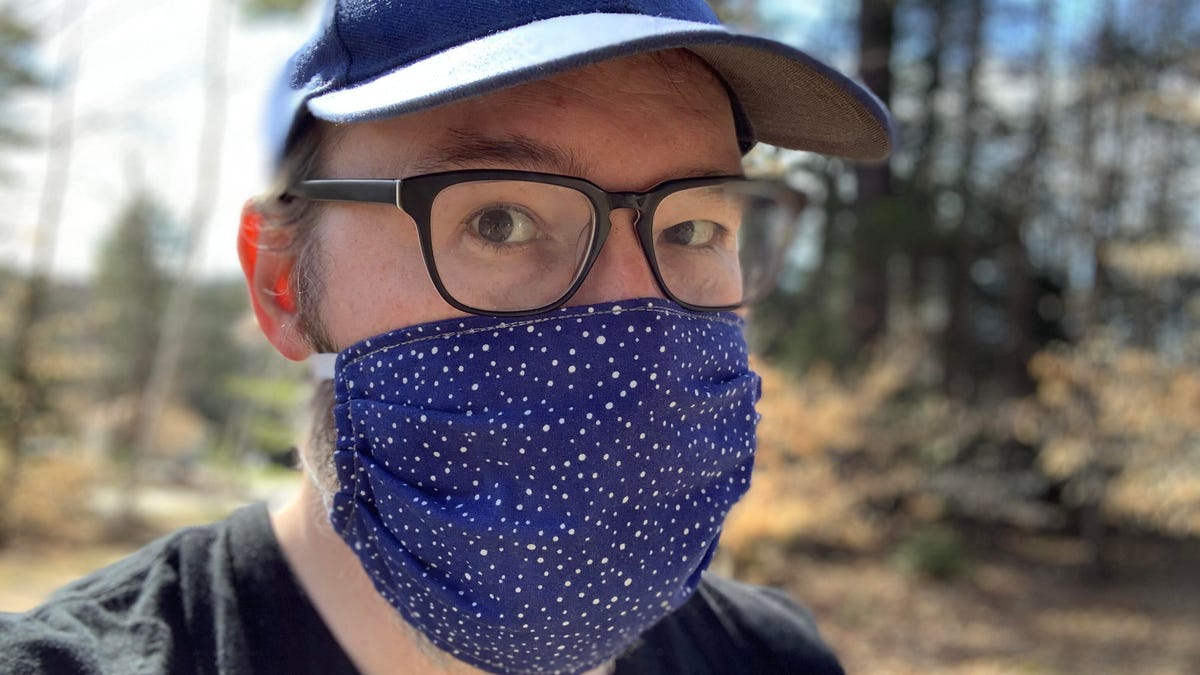 Why You Can Trust CNET
Why You Can Trust CNET Making 3D printed face shields, mask accessories and other coronavirus tools
A simple home 3D printer can make your homemade cloth mask more effective in fighting COVID-19.

A homemade cloth face mask with a 3D printed clip.
I had to go to the supermarket -- one of the only stores still open in the town I'm staying in during the coronavirus pandemic -- but my personal protective options weren't great.
My mother, an accomplished quilter, crafter and creative type, had begun making cloth face masks on a borrowed high-end Bernina sewing machine, and since she was using leftover craft fabric, the designs and colors were at least bold.
But the first batch had long fabric ties. They were OK but never felt especially secure, and they were nearly impossible to adjust without fully untying and retying the mask. For the second wave, she found some elastic to make ear loops, like on a surgical mask, but the elastic was thick and stiff, so what might be a perfectly sized ear loop for one person's ears didn't work on another.
But other options were out there, and I don't mean ordering hard-to-find professional face masks. There's been a renewed interest in at-home 3D printing now that printers can be used for making simple COVID-19 safety gear. Large companies with dozens or even hundreds of professional-grade 3D printers are producing face shield parts and mask clips, as are small businesses with a handful of printers and even individuals with just a single device.
And yet, despite being a prolific 3D printing hobbyist, I was left out on this new and helpful trend. The 3D printers I normally used were off-limits in the CNET Maker Lab in the basement of our shuttered office building.
3D printing a face shield, time-lapse-style.
New gear
After a few weeks working remotely, I was able to get two new 3D printers delivered and immediately set them up to try producing home-made PPE materials.
These were the Da Vinci Jr. 1.0 A Pro and the Da Vinci Mini W Plus, both from XYZprinting, a Taiwanese maker of popular entry-level 3D printers. The Mini W Plus is indeed entry-level (under $200) but out of the box only works with proprietary filament (there's a sold-separately NFC tag that opens it up to third-party printing materials.
The Jr. 1.0 A Pro model was a nice step up for $449, or $579 with both an optional hardened nozzle for specialty materials and a laser engraver (which I have not had a chance to try yet). I liked the large 5.9-by-5.9-inch print bed (150mm by 150mm), but again, using non-XYZ filament was a pain. I didn't need to jailbreak the printer, but I had to set my spool of AmazonBasics PLA filament up outside it, as it would not fit on the proprietary internal spool. You can read more of my hardware impressions of this and other cost-effective 3D printers here.
A 3D printed clip for elastic face masks.
Ear savers for masks
My first prints were of simple hooks that worked with the elastic straps on many homemade cloth masks. Some people call them "ear savers" and there are dozens of different designs available on Thingiverse, Cults3D and other sites that host 3D printer files. The one I ended up liking best is located here.
Glowforge, which makes an excellent lasercutter/engraver of the same name, has a program for making and distributing ear savers laser-cut from acrylic, with the needed files and instructions located here.
A new clip for cloth face mask straps.
Mask strap clips
But elastic can be hard to come by, even Amazon is mostly out of stock. So the majority of masks being made at my kitchen table have long cloth straps. These two-part clips printed easily and attached securely to the cloth straps. Once secured, they made putting on and taking off a cloth mask very easy.
The 3D printed top part of a face shield, with a clear plastic visor added.
Face shields
There are many designs for face shields, but all are essentially a headband with the ability to attach a clear plastic sheet to the front. These are home-made versions of the simple face shields often paired with paper masks in hospitals, and volunteers have been making them in large batches to share locally, as they print relatively quickly.
Here's the specific model I liked best out of the handful I tried printing. Because of the tabs on the top brim, I was able to take clear plastic material and use a simple hole punch to attach it.
A CAD file and 3D printed prototype for a door-opening, button-pressing tool.
Tools for (not) touching
Another popular category is tools for opening doors, pressing buttons and other everyday tasks. Most look like small mountain-climbing hooks (or perhaps very elaborate bottle openers). The curved ends are good for long door handles, not so much for round door knobs, and many have pointers for operating ATM machines, elevator buttons and some kinds of touchscreens (pressure-sensitive resistive ones, not conductive capacitive screens).
Some popular models can be found here and also here. I took a shot at making my own version, designed for maximum strength and utility. It's still a work in progress, but feel free to try it out here.
How you can help
There are many organizations looking to help connect volunteers with organizations that need 3D-printed gear. For example, my colleague Rich Brown has been printing hands-free face shield ties for a volunteer group in Kentucky.

